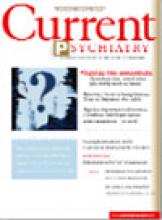User login
In Dr. Willem Martens’ article, “Recovery from schizophrenia: Fact or fiction” (Current Psychiatry, July 2004), dosages listed for several antipsychotics in Table 3 were inaccurate—specifically risperidone (25-50 mg/d) and ziprasidone (10 mg/d). Some clozapine side effects, such as increased blood glucose and weight gain, were omitted.
Also omitted was the fact that haloperidol reduces positive symptoms, while the atypical antipsychotics reduce negative symptoms.
James Patras MD
Assistant professor of clinical psychiatry
University of Illinois at Chicago School of Medicine
Dr. Martens responds
The recommended risperidone dosage was incorrect because the decimals were omitted. The correct dosage is 2.5 to 5 mg/d.
Concerning haloperidol, severely disturbed patients often receive 30 to 40 mg/d, and particularly resistant patients have received up to 100 mg/d. Haloperidol is useful for managing acute and chronic psychosis as well as aggression and agitated behavior.
The normal ziprasidone dosage is between 80 and 160 mg/d but can range from 10 mg/d for less-severe cases to 200 mg/d for exceptionally severe and treatment-resistant patients.
Finally, I did not list all possible side effects; there are too many to mention in such a short space.
Willem HJ Martens, MD, PhD
Director, W. Kahn Institute of Theoretical Psychiatry and Neuroscience
Elst (Utrecht), The Netherlands
In Dr. Willem Martens’ article, “Recovery from schizophrenia: Fact or fiction” (Current Psychiatry, July 2004), dosages listed for several antipsychotics in Table 3 were inaccurate—specifically risperidone (25-50 mg/d) and ziprasidone (10 mg/d). Some clozapine side effects, such as increased blood glucose and weight gain, were omitted.
Also omitted was the fact that haloperidol reduces positive symptoms, while the atypical antipsychotics reduce negative symptoms.
James Patras MD
Assistant professor of clinical psychiatry
University of Illinois at Chicago School of Medicine
Dr. Martens responds
The recommended risperidone dosage was incorrect because the decimals were omitted. The correct dosage is 2.5 to 5 mg/d.
Concerning haloperidol, severely disturbed patients often receive 30 to 40 mg/d, and particularly resistant patients have received up to 100 mg/d. Haloperidol is useful for managing acute and chronic psychosis as well as aggression and agitated behavior.
The normal ziprasidone dosage is between 80 and 160 mg/d but can range from 10 mg/d for less-severe cases to 200 mg/d for exceptionally severe and treatment-resistant patients.
Finally, I did not list all possible side effects; there are too many to mention in such a short space.
Willem HJ Martens, MD, PhD
Director, W. Kahn Institute of Theoretical Psychiatry and Neuroscience
Elst (Utrecht), The Netherlands
In Dr. Willem Martens’ article, “Recovery from schizophrenia: Fact or fiction” (Current Psychiatry, July 2004), dosages listed for several antipsychotics in Table 3 were inaccurate—specifically risperidone (25-50 mg/d) and ziprasidone (10 mg/d). Some clozapine side effects, such as increased blood glucose and weight gain, were omitted.
Also omitted was the fact that haloperidol reduces positive symptoms, while the atypical antipsychotics reduce negative symptoms.
James Patras MD
Assistant professor of clinical psychiatry
University of Illinois at Chicago School of Medicine
Dr. Martens responds
The recommended risperidone dosage was incorrect because the decimals were omitted. The correct dosage is 2.5 to 5 mg/d.
Concerning haloperidol, severely disturbed patients often receive 30 to 40 mg/d, and particularly resistant patients have received up to 100 mg/d. Haloperidol is useful for managing acute and chronic psychosis as well as aggression and agitated behavior.
The normal ziprasidone dosage is between 80 and 160 mg/d but can range from 10 mg/d for less-severe cases to 200 mg/d for exceptionally severe and treatment-resistant patients.
Finally, I did not list all possible side effects; there are too many to mention in such a short space.
Willem HJ Martens, MD, PhD
Director, W. Kahn Institute of Theoretical Psychiatry and Neuroscience
Elst (Utrecht), The Netherlands
